‘Barrage of bullets’: Officer Sino Seng testifies about ambush that wounded him, killed partner
[anvplayer video=”5195054″ station=”998131″]
ROCHESTER, N.Y. – For the first time, Rochester Police Officer Sino Seng publicly recounted the ambush that left him injured and his partner mortally wounded.
Dressed in his police uniform, Seng walked into court Thursday just after 2 p.m. to face Kelvin Vickers, the alleged shooter. He’s on trial for killing Officer Anthony Mazurkiewicz.
Video: Officer Sino Seng walks into court
The ninth day of testimony started with videos of two shootings that happened the day before Mazurkiewicz was killed. Vickers is on trial for killing Officer Mazurkiewicz and wounding of Officer Seng on Bauman Street in July 2022 while they were working undercover in their minivan.
Seng told the jury he and Maz swore out loud when bullets started flying. Seng said he saw muzzle flashes coming from a bush.
“It felt, like, just a barrage of bullets.”
Officer Sino Seng
Shaking from pain, Seng said he got out of the car, and, holding his breath, fired two rounds toward in the area of the bush where he saw the flashes. When the shots stopped, he was scared – worried the shooter was going to come around the other side of the van.
Ofc. Seng testifies that he and Ofc. Mazurkiewicz drove by the Laser Street home where the car was that they were looking for before “taking position” on Bauman Street. @news10nbc
— Jennifer Lewke (@WHEC_JLewke) October 5, 2023
Officer Seng testifies that during their surveillance on 52 Laser St, he noticed a “group of males seemed agitated,” on the driveway, it was suspicious.
— Eriketa Cost (@eriketacost_tv) October 5, 2023
“We thought our cover was blown.”
In total, Vickers is facing 24 charges for crimes that happened over the span of three days in July of 2022. Prosecutors say that Vickers is a gang member brought in from Boston during a turf war between factions over the illegal marijuana trade.

Vickers is also accused of shooting three other men on North Clinton Avenue the day earlier. Two of those men, Ricky Collinge Jr. and MyJel Rand, died. Mazurkiewicz and his partner were investigating those murders and an illegal marijuana trade when they were ambushed in their unmarked cars.
[anvplayer video=”5195000″ station=”998131″]
News10NBC investigative reporter Jennifer Lewke is covering the trial from start to finish at the Hall of Justice. Follow her on Twitter for the latest updates.
Day nine (Thursday)
Day nine of the trial started with the jury seeing video from two shootings at 55 Laser St. that happened the day before Officer Mazurkiewicz was killed. One shooting happened at 8:25 a.m. and the other at 9:45 a.m.
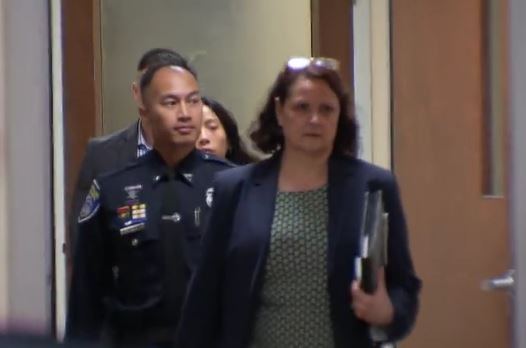
Rochester Police Officer Sino Seng walks into court on Oct. 5, 2023 to testify. (Photo: Jeff Hamson/WHEC)
In both shootings, it appears that more than a dozen shots are coming from the same black sedan. The prosecution showed how close the location of those shootings were to the vacant home on Laser Street where officers found Vickers the next night, after the ambush that killed Officer Mazurkiewicz.
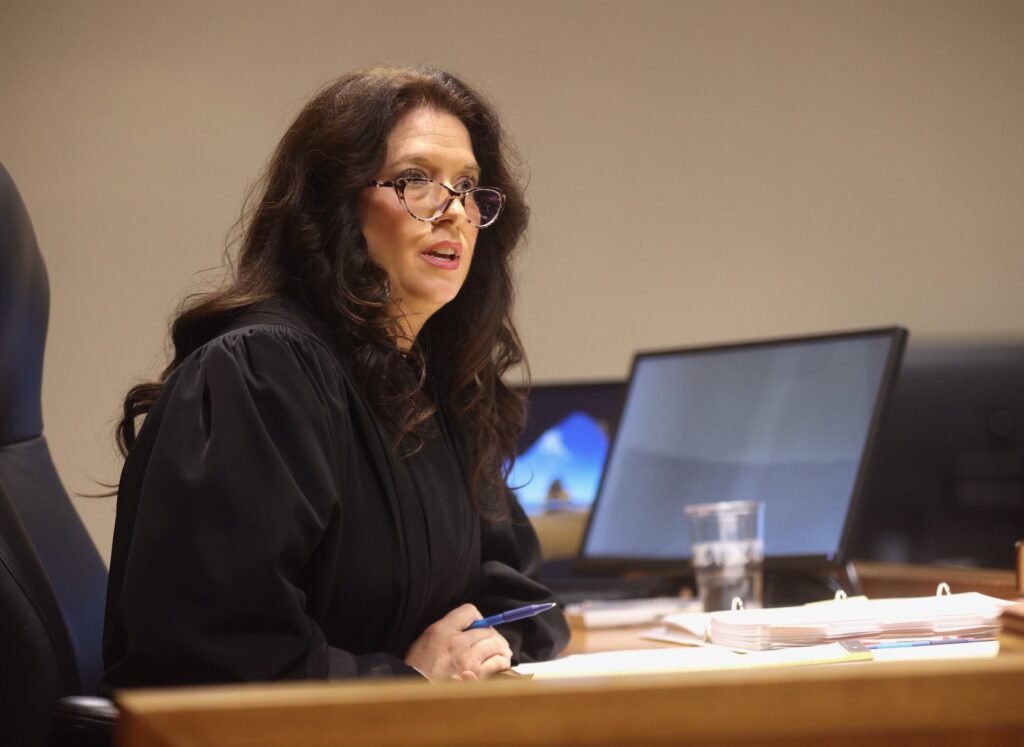
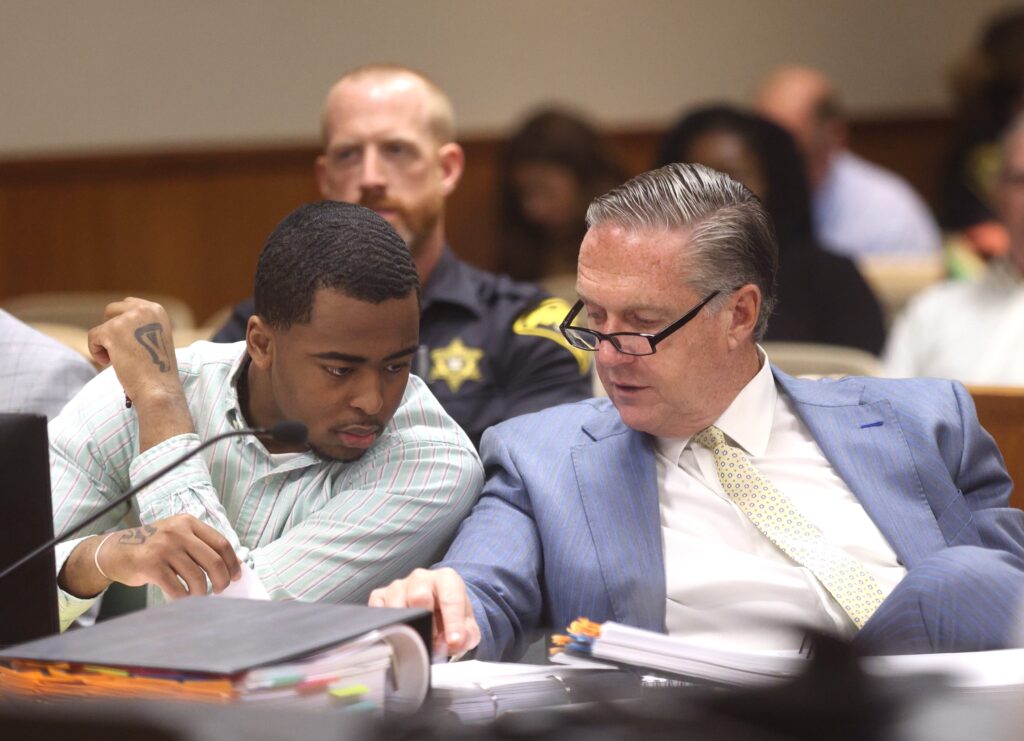
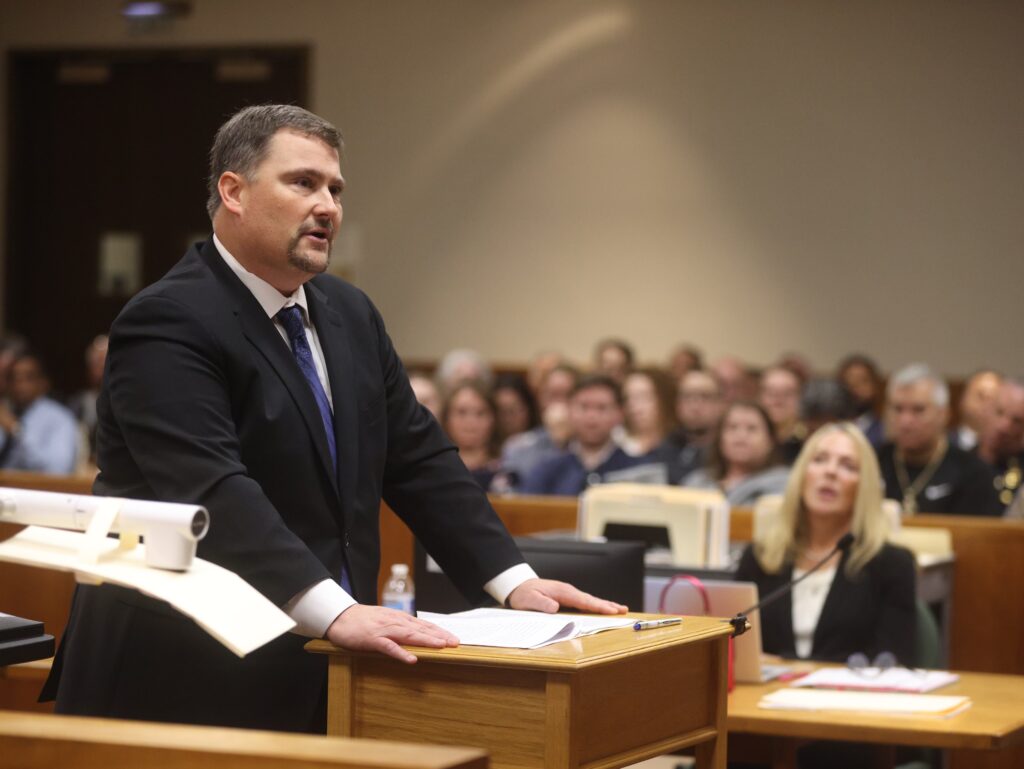
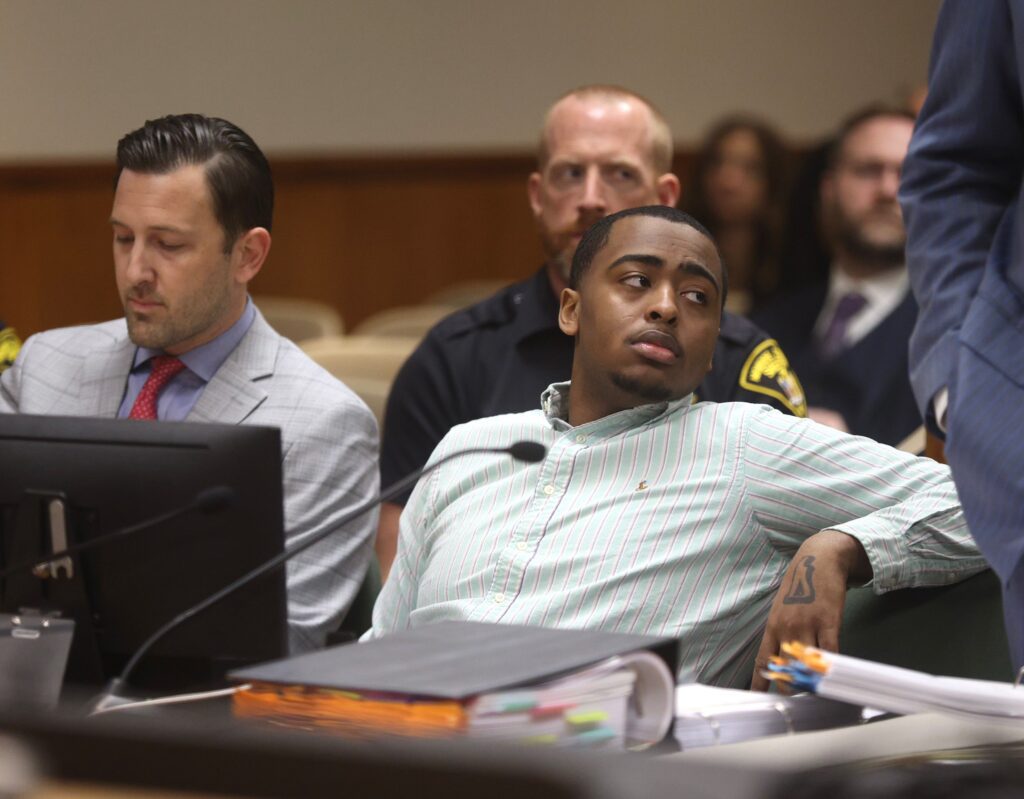
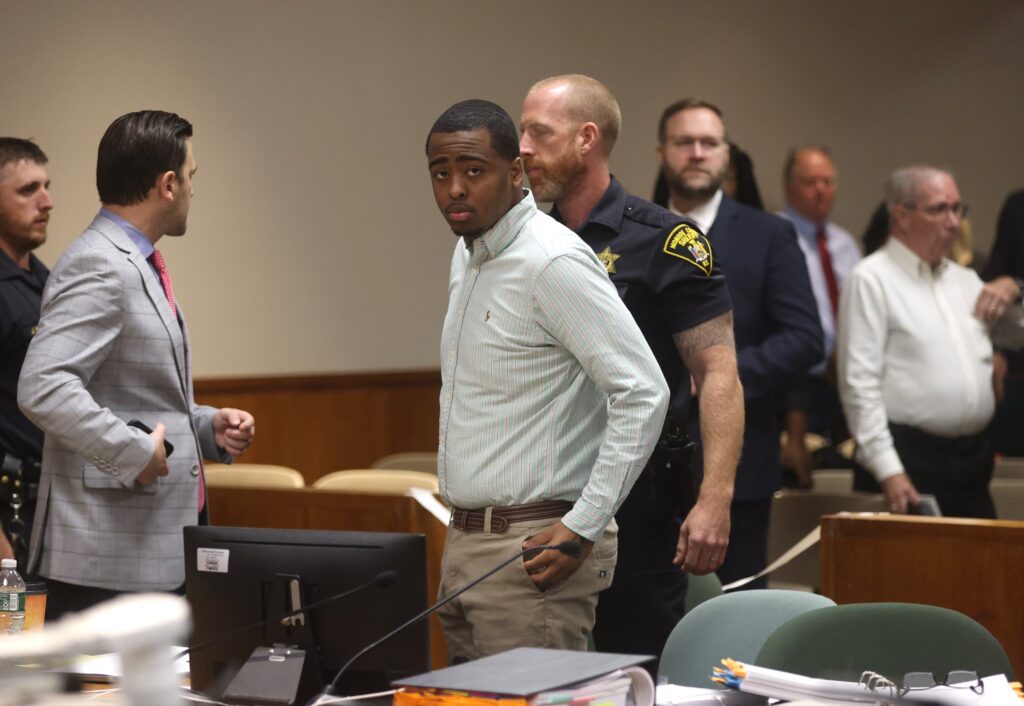
RPD Officer Gregory Buttran, who responded to the hospital where Officer Sino Seng was taken for treatment, was the first to testify. Through tears, he said Seng was in a lot of pain from being shot in both legs and the left hand.
Buttran said he helped to collect two Glock handguns, a rifle, a 12 gauge shotgun, and two boxes of ammunition from the backyard of the abandoned home on Laser Street where officers found Vickers hiding in a crawl space. He also recovered a night owl surveillance system from a bedroom.
Buttran also testified that he found keys of a silver 2010 Dodge Caliber at the abandoned home. He said the keys belonged to a car that was tied to the triple shooting on North Clinton Avenue the day earlier. That car had been found burned a few streets over. Buttran said officers also recovered five garbage bags full of marijuana at the Laser Street home.
The jury also watched video of the moments before Officer Mazurkiewicz was fatally shot. As the video was playing, his wife Lynn quietly cried. The captain of the Tactical Unit sat behind her, gently rubbing her shoulders, her son sitting next to her.
The district attorney showed surveillance video from the drug houses along Laser Street in Rochester where Kelvin Vickers was staying when she said he ambushed the minivan that Officer Mazurkiewicz was sitting during an undercover detail and killed him.
Vickers’ defense attorneys have argued there was an on-going gang war in that area and indicated their client didn’t know Mazurkiewicz was a cop.
The two homes along Laser Street. where investigators say Kelvin Vickers was staying when he shot and killed Officer Mazurkiewicz and wounded Officer Seno Seng, were drug packaging and distribution sites. They had several cameras both inside and outside. Investigators confiscated those systems with search warrants and collected all the video evidence of Vickers’ movements in the hours leading up to the shooting.
Vickers’ defense attorney continues to argue that the street was rife with crime and his client was on edge that rival gang members were out to get him.
“If you listen to the testimony since day one, I think every single witness has testified basically saying there’s nothing but shots fired in that whole area almost on a daily basis. So, this is an area of the city that’s very dangerous, there’s been a ton of guns found in that area, a ton of casing in that area,” said Mike Schiano, Vickers’ defense attorney.
Prosecutors are expecting to wrap up their case against Kelvin Vickers by the end of the week. Then, his attorneys will have their turn at presenting a defense.
Day seven (Tuesday)
DNA evidence was at the center of Tuesday’s testimony in the Vickers trial. Jurors heard officers testify on Monday about finding Vickers in a crawl space of an abandoned home right next to the mini-van where officers Mazurkewicz and Seng were ambushed. On Tuesday, Monroe County Crime Lab forensic biologist Mara Sommer testified that a gun found inside a bathroom of the abandoned home had Vickers DNA all over it.
The jury saw a number of pictures from inside the abandoned home on 63 Laser St. where Vickers was found without a shirt or shoes on. After taking him into custody, Rochester Police got a search warrant for that house and testified that they found a 9mm Glock handgun with one round in the chamber, wrapped in a sweatshirt in the bathroom.
Officers say they also found a magazine for that gun with a capacity of 27, with just one round left in it. Investigators also testified that they found red sneakers in a toilet in the hallway. All of that evidence was tested for DNA. Sommer said that while the gun matched, the rest of the items had too much DNA on them from too many sources to accurately compare to Vickers. That’s a point that Vickers’ defense attorney focused on during cross examination.
“There are issues as to who the actual shooter was, who possessed this weapon,” said Vickers’ defense attorney Mike Schiano. “Clearly this weapon was possessed by numerous people over the course of the events of 72 hours by the fact that there’s at least 3-4 contributes on each item that’s in there. That’s important, something we’re going to be arguing down the road.”
Monroe County District Attorney Sandra Doorley says DNA evidence on the gun is just the start of the case against Vickers.
“There’s a lot more evidence to come and there’s a lot more information that the jury is going to see,” Doorley said. “There’s a lot more information that’s going to be tiring this defendant to the murder of Officer Mazurkiewicz and the attempted murder of Officer Seng.”
Day six (Monday)
Jurors saw body-worn camera video of officers discovering Vickers in a crawl space near an abandoned house, just feet away from where Rochester Police Officer Anthony Mazurkiewicz was shot and killed less than an hour before.
The video shows the 22-year-old Vickers come out of the crawl space wearing just pants — no shirt or shoes — and covered in sweat. He followed officers’ commands and came out with his hands up. The video shows him telling tell officers his name, date of birth and that he was from Boston, but nothing more. Most of the time he was standing, handcuffed and staring straight ahead.
“We have him at the crime scene, we have him hiding just feet away from where Officer Mazurkiewicz was shot dead,” Monroe County District Attorney Sandra Doorley said. “There will be more testimony that will connect him further, but he’s there at the crime scene, his clothes are missing –which is important to note — and yeah, there are 14 casings and one projectile found right in the yard area of 63 Laser Street.”
Vickers’ attorney says that in the coming days the defense will work to explain the intent of people who were on the street at the time Officer Mazurkiewicz was shot.
Jennifer Lewke: “Why was he in that house, by himself in the crawl space?”
Mike Schiano, Vickers’ attorney: “I think we’re getting a little premature as to what exactly happened here. You’re going to see over the course of the next few days exactly what our defense is going to be in terms of what the intent of individuals were on that street at the time so, again, it’s a little premature to get there but you’ll see, it’ll come to more of an explanation at the end of the case.”
Trial postponed (Friday)
The trial was postponed on Friday due to “unforeseen circumstances.” Sources tell News10NBC that Vickers was with someone who overdosed in the Monroe County Jail. For that reason, he was required to be observed for 12 hours, which would have stretched into the start of the trial Friday. A spokesperson for the Monroe County Sheriff’s Office says Vickers’ health is fine and he never left the jail.
It was an emotional day Thursday for those who knew and loved Rochester Police Officer Tony Mazurkiewicz, as his fellow officers who were with him when he died told the jury what happened.
Kelvin Vickers is on trial for Officer Mazurkiewicz’s murder. Prosecutors say Vickers fired more than a dozen shots into the van Mazurkiewicz and his partner, Officer Sino Seng, were sitting in, during an undercover detail in July 2022.
A number of members of the Rochester Police Tactical Unit, who were on that same undercover detail, testified Thursday. It was a very tough day for them — and for Mazurkiewicz’s family, who has been in the courtroom for the entirety of this trial.
These tactical officers were with Mazurkiewicz during his final moments. Some pulled him out of the minivan after he had been shot, and carried him to a police cruiser. One of them sat behind him on the way to the hospital, holding him up, trying to keep him awake and breathing.
More than a half dozen of these officers told the jury of what happened in the few minutes leading up to the shooting and what happened after.
It turns out that Mazurkiewicz was on the phone with his sergeant when the shots were fired. His last words to him were “Shots fired, send the cars.” Fellow tactical team members were within a block and raced to the scene. One testified to helping Officer Sino Seng, who had been shot in the legs but was able to get out and draw his gun. Other officers testified to helping get Mazurkiewicz out of the van and into the back of a police cruiser. They said they made a decision to take him to Strong Memorial Hospital because his injuries were bad.
Every member of the tactical team said they stayed at Strong with the Mazurkiewicz family until his body was released to the medical examiner.
“They were all there that evening, they all had bits and pieces of evidence to contribute to the overall picture that we’re trying to paint for the jury,” Monroe County District Attorney Sandra Doorley said. “It was very emotional for a lot of them — Officer Mazurkiewicz was their friend, they had worked with him for years, some of them have known him for over a decade.”
One of those tactical officers testified to staying behind initially to set up a perimeter in hopes of finding the person who shot his colleagues. He said he noticed a vacant home nearby and gathered a team of officers to search it. That’s where they found Kelvin Vickers hiding, according to the testimony, with no shirt or shoes, just wearing long shorts.
Under cross-examination by Vickers’ defense attorney, all of the tactical officers said they did not know that there had been a shooting on that same street a day earlier before they were assigned to surveil a home on it.
“That’s going to be critical to intent here because again, you have officers who are over there, investigating or doing surveillance, not knowing that there’s been this violence, gang violence between these two factions for the past 48-72 hours and 32 shots had been fired at 55 Laser St.,” said Mike Schiano, Vickers’ defense attorney. “And now you have all these people just making laps around this house — and again, you’ll see video later on either this week or next week that shows these individuals on edge during the course of this whole period of time.”
The District Attorney’s Office wrapped up it’s case in the North Clinton Avenue murders after four days of testimony. The final witness in the murders of Myjel Rand and Ricky Collinge Jr. was a police investigator.
During his testimony, jurors saw a compilation of videos that showed Kelvin Vickers inside a known drug house with what appears to be a gun in his hand.
That house had a number of cameras in and around it, and that’s all video that the jury has and will be seeing throughout this trial. The DA’s Office has now moved on to their case against Vickers in the murder of Officer Tony Mazurkewicz.
Maz’s wife Lynn has been in the courtroom since the start of this trial and Wednesday she was joined by her husband’s former longtime partner and best friend, Dennis Cole. Several members of the Rochester Police Tactical Unit have also sat with Lynn throughout this trial.
“I do think that the video is of such quality and clarity that the jury should not have any difficulty in determining for themselves what actually happened,” says Assistant District Attorney Perry Duckles.
“There’s been an ongoing dispute between a number of factions in the city that were turf wars, there was shootings going back and forth between these two gangs,” explains Vickers’ defense attorney, Mike Schiano. “It was a very violent time in the City where these people were shooting up houses, burning cars, and basically shooting at each other during a two to three week period, and I think you’ll hear more about that over the course of the next two to three weeks.”
Day three (Tuesday)
Multiple evidence technicians, the people who recovered bullet casings and other objects on North Clinton Avenue after the shooting, took the stand on Tuesday.
The District Attorney’s Office asked RPD evidence technician Ryan Radel whether any of the casings or projectiles on North Clinton Avenue looked rusted or had been sitting there for a while. He answered no. Defense has argued that shootings happen frequently on North Clinton Avenue so it’s difficult to determine if Vickers was the gunman.
Radel also testified about collecting bullet fragments that the Medical Examiner’s Office recovered from the body of at least one of the gunshot victims. The jury also heard from technicians who gathered surveillance and security video from cameras in the area.
Jerry Ingram, who lives in the North Clinton Avenue neighborhood, was the first witness to take the stand on Monday. Ingram said he was outside watering a garden with his grandkids when he heard multiple gunshots. He described it as a small, “wagon” type vehicle speed away from the scene.
Ingram say the vehicle he saw leave the crime scene is the same vehicle captured on a traffic camera at a nearby intersection. During cross examination, he said his neighborhood has been “infiltrated” by crime.
After Ingram, RPD Sergeant Matthew Webster, among the first officers to respond to the North Clinton Avenue shooting, took the stand. Webster said he tracked a Dodge Caliber from the scene of the shooting all the way to Avenue D. Then, he lost it on the blue light cameras. Webster said he later got a call about a car, a Dodge Caliber, on fire on Weyl Street.
RPD Officer Richard Schone also took the stand. He responded to the North Clinton Avenue shooting and found Tireek Burden, the victim who survived, with a gunshot wound to the leg.
Burden is the nephew of Collinge, who was killed. The jury saw the officer’s body-worn camera video, where Burden can be heard saying, “Oh my God, bro! Is my nephew dead?” Despite his leg injury, he tries to get up and limp around the corner to see his nephew.
Dr. John Deangelis, an emergency room physician at Strong Hospital, testified that he treated Tireek Burden. He found metallic fragments through the leg consistent with a gunshot wound.
Dr. Deangelis confirmed that the fragments he removed from Burden’s leg are the fragments that the DA’s office entered into evidence. Dr. Deangelis also treated Myjel Rand, who eventually died at the hospital. He was initially awake and talking, despite having a bullet in his elbow and right side of his body.
When Rand went into surgery, his vitals declined and doctors found blood in his belly along with other severe internal damage. He survived initial surgery but his health continued to decline until he died. Doctors retrieved bullet fragment in the right abdomen near his spine.
Trial postponed (Friday)
The trial was postponed on Friday because a juror had food poisoning and a witness for the District Attorney’s office was also sick.
The trial began on Thursday with the prosecution and defense delivering opening statements, which lasted about an hour and then testimony began.
During opening statements, Assistant District Attorney Perry Duckles told the courtroom Mazurkiewicz’s last words, which were: “Shots fired. Start the cars.” He said Seng will testify during the trial.
“Shortly after 9:17 p.m., he would be rushed to Strong Memorial Hospital by members of the Rochester Police Department’s Tactical Unit,” Duckles said. “Despite the efforts of medical personnel, he would die later that night. His brothers and sisters in blue standing by, his partner Sino Seng, was lucky enough to survive the ambush, though that is small comfort. He was injured in the line of duty but survived and you will hear from him during the course of this trial.”
Mike Geraci, Vickers’ attorney, reminded jurors to keep and open mind and to assume that Vickers is innocent.
“You promised that you would do a number of things performing your duties as jurors,” Geraci said. “You promised you would keep an open mind and uphold the law as instructed by Judge Hahn. That law, very importantly, includes presumption of innocence. As we sit here today, Kelvin is cloaked by that presumption.”
Before opening statements, the victims’ families walked in the courtroom together. Lynn Mazurkiewicz, the wife of Tony Mazurkiewicz sat in the front row of the gallery about 10 feet from Vickers. The parents of Ricky Collinge Jr. were also in the courtroom. The mother of Collinge Jr. spoke with News10NBC about the murder of her son.
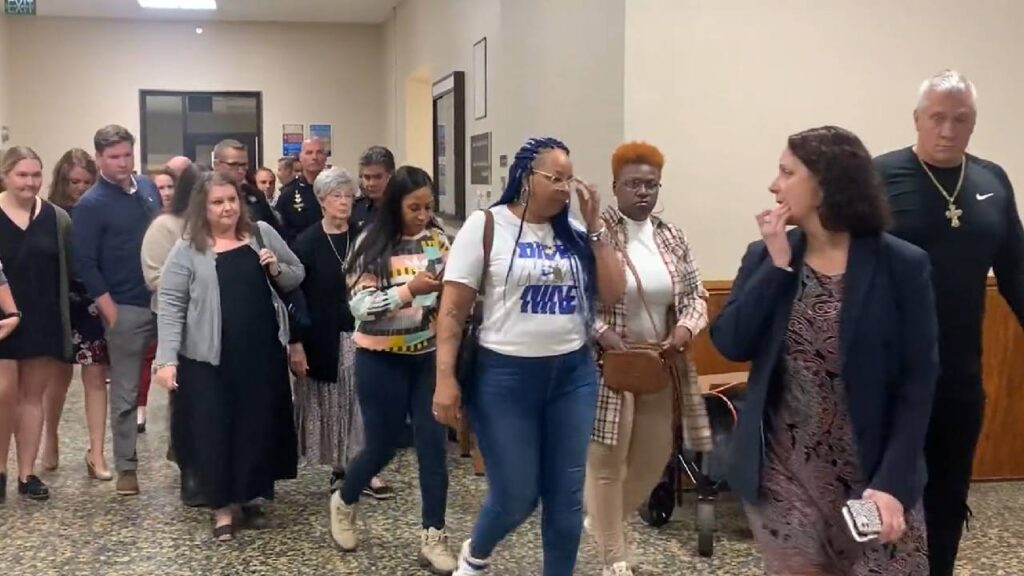
Some RPD command staff attended the trial in plain clothes. Only 10 uniformed officers are allowed in the courtroom at a time because of percent set years ago but plain clothes officers are allowed.
Vickers remained fairly stoic during the first day, at times leaning over to his attorneys to talk about the testimony given. At one point, during a short recess, the Mazurkiewicz family stood up together, staying in the courtroom to look him in the face as he was taken into a holding room in the back.
“The family will be here everyday, members of law enforcement will be here everyday,” said Monroe County District Attorney Sandra Doorley. “We have support from my office that will be with them but you also have to remember the two other individuals here, their families will be here as well and we intend to support them. What we plan to do is present this case chronologically and in an order that the jury can understand what happened over the course of three days.”
Lead-up to the trial
The trial began after three days of jury selection, which wrapped up on Wednesday with the selection of the final two jurors and four alternates. Attorneys and a judge screened 220 people and selected six men and six women of all different races and walks of life.
Investigators say Vickers was part of a nationwide gang and was brought in from Boston to retaliate against rival drug dealers. Mazurkiewicz and Seng were in plain clothes, working an undercover investigation into an illegal marijuana trade and the shootings on North Clinton Avenue, when they were ambushed in their car. Within hours, Vickers was found hiding in a crawl space in a vacant house on Laser Street and taken into custody. Police say they found the gun used to shoot the officers with him.
RPD says that, while ambushing the two officers, Vickers also hit a then-15-year-old girl with a stray bullet. The charges for shooting the 15-year-old were dropped.
The most serious charge Vickers faces is aggravated murder for killing Officer Mazurkiewicz and aggravated attempted murder for wounding Officer Seng. For the jury to find him guilty on those charges, prosecutors need to prove that Vickers knew he was shooting officers.
Prosecutors charged Vickers under the 2005 Police Officer Protection Act. If Vickers is found guilty of the aggravated murder of Mazurkiewicz under the act, he’ll automatically get life in prison without a chance at parole. Vickers’ other charges include assault, possessing illegal guns, and arson for allegedly setting a car on fire.
News10NBC’s prior coverage:
- Vickers to be tried separately in RPD officer’s murder case (Aug. 2023)
- U.S. Attorney: Bloods in Rochester last summer, gang war led to murder of Officer Mazurkiewicz (June 2023)
- Gang-affiliated drug war exposed by RPD included shootings, murders and arson over marijuana (Oct. 2022)
- RPD: Alleged cop killer hired to kill rival gang members in an ongoing marijuana drug war (Oct. 2022)
- RPD says Kelvin Vickers came to Rochester alongside others to kill rival marijuana dealers (Oct. 2022)
- Arson links murder cases including the shooting death of RPD Officer Tony Mazurkiewicz (Sept. 2022)
- Family of accused cop killer speaks publicly for the first time and complains about jail conditions (Aug. 2022)
- Kelvin Vickers pleads not guilty to murder of RPD officer (Aug. 2022)
- Accused cop killer has a long rap sheet that starts when he was 12 (Aug. 2022)
- 15-year-old shot in gunfire that killed RPD officer says it’s ‘really scary because I was just in my own house’ (July 26)